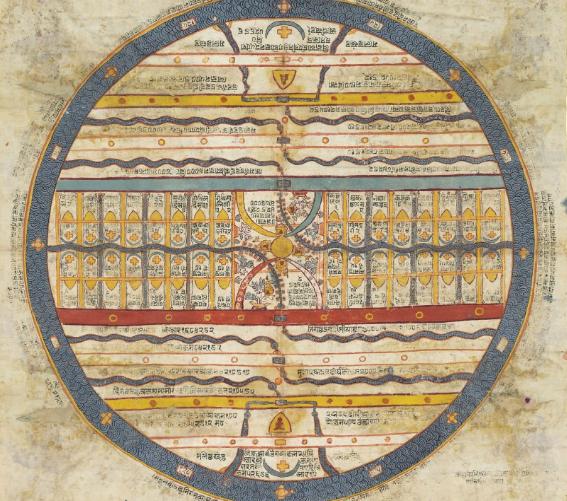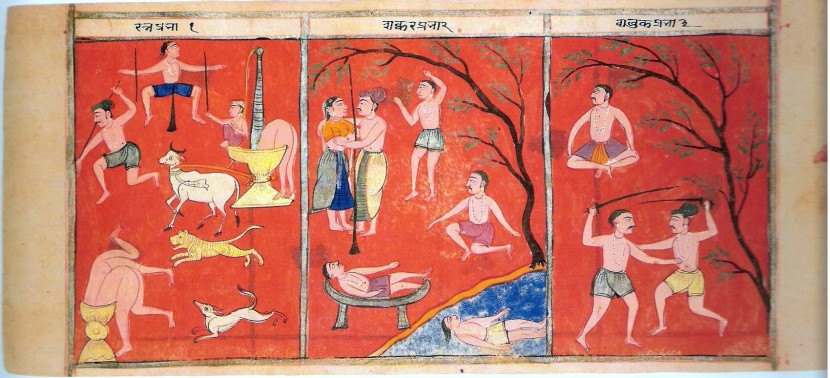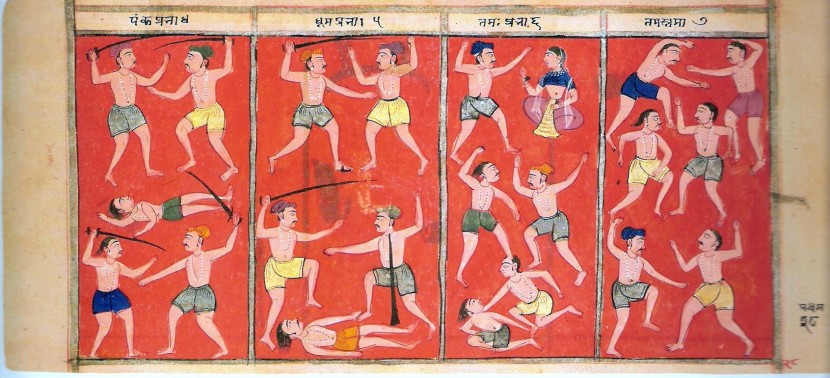Areas of the Universe
1. The middle world (Madhya loka)2. The Nether worldThis is also known a the animal world (tiryancha loka). It lies on the circular upper surface in the center of Universe. It is one Rajju broad and long. The other worlds, with their hells lie below it; and the heavenly world, the Dev Lokas, at the height of 100,000 Yojans above it.
Mount Meru is at the center of the middle world. The continent, known as Jambudwip, surrounds it in the form of a circle and its diameter is 100,000 Yojans. A ring formed ocean surrounds the Jambudwip. It is an ocean of the salt (lavanoda) and in its diameter is 200,000 Yojans. The continent called Ghatki Khand joins them, again in the form of a ring, and in diameter is 400,000 Yojans. Ghatki Khand is also bordered by a circular ocean. Thus, there are series of continents, and countless oceans one after the other, finally up to Swayambhu Raman ocean which washes around the whole middle world i.e. Madhya loka.
The names of the first eight of them are:
Continent
Ocean
1.
Jambudwip
Lavanoda (Salt-ocean)
2.
Ghatki Khand
Kaloda (Black sea)
3.
Puskarvar Dwip
Puskaroda (Lotus ocean)
4.
Varun Var Dwip
Varunoda (Varun ocean)
5.
Kshir Var Dwip
Kshiroda (Ocean of milk)
6.
Ghrut Var Dwip
Ghrutoda (Butter milk ocean)
7.
Ikshuvar Dwip
Iksuvaroda (Sugar ocean)
8.
Nandishwar Dwip
Nandishwaroda
The continents have been given the names as per their characteristics marks; which are peculiar to them. The oceans are given the name of such liquids, which resemble the water of ocean.
Of all the dwips (islands) Jambudwip is very significant because it is in the center of the whole universe. Jains believe that our India and the present world as we see, exist in Jambudwip.
Adhai-dwip (two and a half continents) with Jambudwip in the center.
Jambudwip is surrounded by a very high and broad wall. The wall is supposed to be made from precious gold, diamonds and such other jewels. Even the grill work is done by gold and diamonds. There are four mighty gates, protected by deities.
Jambudwip continent has six mighty mountains, dividing the continent into seven zones (kshetra). The names of these zones and mountains are as under:
Zone
Mountain
1.
Bharat Kshetra
Himavan mountain.
2.
Haimava Kshetra
Maha-Himavan mountain
3.
Hari Kshetra
Nishadha mountain
4.
Videh Kshetra
Nila mountain
5.
Ramyak
Rukmi mountain
6.
Hairanyvat Kshetra
Shikhari mountain
These mountains consist of gold, silver and beryl. On the eastern summit of every mountain, there are Jain temples embellished with jewels. There is a large lake on each mountain with lotus flowers.
Fourteen rivers spring from these six mountain which flow into the salt ocean which again frames the different zones of Jambudwip. The south most zone is Bharat Varsh. It is bordered by Himavan mountain in the north. On another side, there is a salt ocean. We live on Bharat Varsh (India) which is part of Jambudwip. Vaitadhya mountain running parallel to Himavan divides Bharat Varsh into two parts - northern and southern half. The rivers Maha-Sindhu and Maha-Ganga flow down from Himavan into west and east respectively divide each one of these halves into three parts. Thus whole Bharat Varsh is divided into six parts.
Bharat Varsh is a Karma Bhumi i.e. it is a land in which human beings have to work, and in which all sorts of Karmas can be bound (by soul). The periodical changes of six aras take place in it.
The Himavart Varsh zone, in north of Himavart mountain is four times bigger than Bharat Varsh. Shabdpati mountain lies in its center. Himvat Varsh is a Bhog Bhumi, i.e. a land in which human beings live the life of pleasure almost like fruits of Kalpa Vriksha (the wonderful wishing tree). Here prevails an age of only pleasure.
Jambudwip framed by the Lavanoda (salt-ocean). Maha Videh (central area of Jambudwip) is accentuated in this depiction.
Harivarsh zone is on northern side of Himavan Varsha. It is four times broader than the former. The conditions of life here are better than Himavart Varsh. Here prevails an ara (age) of Susma.
The Nisadha mountain separates Harivarsha from Videh Varsh. This is Maha Videh Kshetra. It is largest of all the Kshetras. The mountain Meru (Mandar) lies in the middle of this kshetra. Meru is, in a way, center or Naval of the whole Jambudwip. On all the summits, there are beautiful lotus ponds, palaces, temples. Two big rivers Sita and Sitada flow at the foot of Meru.
Vakara mountain ranges start from Meru.
- Saumanas mountain consisting Silver.
- Vidhut Prabha mountain consisting Gold.
- Gandh Madan mountain consisting Gold.
- Malyavan mountain consisting Beryl.
Devkuru and Uttarkuru are two most fortunate of all Jambudwip region, because here is an era of all Susma Susma. Thus here there is only happiness permanently. In Purva Videh and Upper Videh, there is the land of Karmas - Karma Bhumi, like Bharat Varsh. Ramyak Varsh zone is an exact counter part of Hari Varsh while Harin Varat is exactly like Haimavata and Airavat Varsh is like Bharat Varsh.
The whole Jambudwip is in a circular form. It is encompassed by a salt ocean. In its center, there is a gigantic barrel like container (Patali Gods have their abode there. There are series of island in Lavanda and fifty-six median islands.
3. The world of Gods:Seven subterranean regions lie story-like, thousand Yojans deep, under the earth of middle world. Of these, only the upper ones serve as an abode for certain divine beings while the others shelter the hells where the souls for their bad deeds have to undergo horrible tortures.
The uppermost subterranean region is Ratna Prabha, having divided into three stories under one-another. Of these the third one of Ratna Prabha serves as a place of punishment for those who are condemned.
Torture in Hells: Ratna prabha, Sharkara prabha and Valuka prabha.
Each region of the hells has several stories. There is a central hell in the center of every story. Numerous row-hells spread from here into four directions. The number of hells decreases when one moves downwards.
Ratna Prabha (Shine of Jewels) have thirteen stories and 30,00,000 hells. That is on the top. On 7th Mahatma-Prabha (Shine of great darkness) there is only one story and only 5 hells) from 1st to 7th totally there are 49 stories and 84,00,000 hells. The inhabitants of hell, unlike human beings on the earth, are born in super natural manner - by suddenly coming out of the hole in a wall and falling down. Their complete evolution takes one muhurat (48 minutes). Their structure is completely unsymmetrical. They have only first three kinds of knowledge and have transcendent knowledge of material things. All these knowledge only add to their sufferings.
Torture in Hells: Panka prabha, Dhuma prabha, Tamaha prabha and Mahatamaha prabha.
Self discipline is not possible here; therefore they cannot rise beyond 4th stage of Guna Sthanakas. The deeper the hells, worse are their inhabitants, greater are their pains. Life span in lowest stories is the highest.
The conditions are horrible in hells. The smell is pestilent, the air is sharp and pungent and there is constant awful darkness. Walls and floors are covered with dirt and they are slippery everywhere. All kinds of punishment and ill-treatment are provided. The torturing include hacking to pieces, broken on a wheel, being roasted, skewered impaled, whipped cut with knives, droned in water, boiled in cauldrons etc.
Gods live the life of happiness. They have magnificent palaces to stay where they enjoy all pleasures of life. Their every wish is fulfilled. Here also self-discipline is impossible among them. The Main types are Bhuvanvasi, Vyantar, Jyotiska and Vaimaniks. The minimum life span is 10,000 years and maximum is 33 Sagarpoam. Their appearance is marvelous, youthful and radiant. They have no shadow. Their eyes do not twinkle and their hairs and nails do not grow. Everything is illuminated with the glitter of precious stones and diamond.



